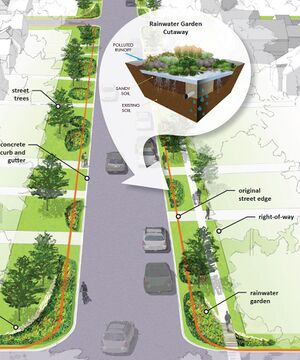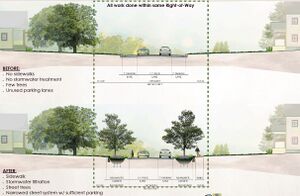
Overview of green stormwater infrastructure (GSI) and sustainable stormwater management


Green stormwater infrastructure (GSI) describes stormwater practices that use natural systems (or engineered systems that mimic or use natural processes) to capture, clean, and infiltrate stormwater; shade and cool surfaces and buildings; reduce flooding, create wildlife habitat; and provide other services that improve environmental quality and communities’ quality of life. Examples include green roofs, bioretention, tree trenches, and vegetated swales (Tucson). GSI is one component of green infrastructure, which refers to ecological systems, both natural and engineered, that act as living infrastructure. Green Infrastructure elements are planned and managed primarily for stormwater control, but also exhibit social, economic and environmental benefits (Syracuse University).
Contents
Sustainable stormwater management and environmental sustainability
The United States Environmental Protection Agency (US EPA) describes sustainable stormwater management as focusing on reducing runoff and improving water quality. Often also called low impact development (LID), sustainable stormwater management includes a variety of practices that help maintain natural hydrologic cycles through site grading, vegetation, soils and natural processes that absorb and filter stormwater onsite, while also minimizing erosion, flooding and water pollution (US EPA).
Sustainable stormwater management is one component of environmental sustainability. Broadly, environmental sustainability is managing natural resources and protecting global ecosystems to support health and wellbeing, now and in the future ([1]).
For a discussion of the role of GSI in sustainability and ecosystem services, see Multiple benefits of green infrastructure and role of green infrastructure in sustainability and ecosystem services.
Examples of sustainable stormwater management and practices
Green stormwater infrastructure can be implemented at the site, neighborhood, watershed, and city scales. Strategies vary with local factors, such as soils, hydrology, regulations, and social factors (e.g. acceptance, environmental justice, etc.). Infiltration or other methods of retaining water on-site are typically preferred, but may not be feasible due to constraints. As the implementation area increases, it often becomes easier to accommodate stormwater retention since there are more potential locations where retention is feasible. Examples of how implementation varies with scale are provided below.
- Site scale: Typically involves one or more practices, such as permeable pavement, bioretention, and rooftop disconnection. Soils, utilities, and site configuration (e.g. size) are often constraints to retention.
- Neighborhood scale: Typically involves practices used in tandem, such as multiple bioretention practices connected by vegetated swales. Neighborhood prevention efforts may also be included, such as residential yard practices (e.g. rain barrel programs, leaf pickup programs).
- Watershed and city scale: Involves multiple practices used in tandem. Larger areas may be divided into individual neighborhoods where different opportunities exist. Social factors are often considered, such environmental justice. Priority areas may be established, such as areas near sensitive receiving waters. Large-scale watershed or comprehensive plans may be developed. Regulatory constraints or incentives may be developed, including ordinances and zoning efforts.
For case studies of GSI implementation and planning, visit the following pages.
- Planning green stormwater infrastructure projects and practices
- Green stormwater infrastructure - planning case studies
Several cities, watersheds, and regions have developed sustainable stormwater or green infrastructure plans. Some examples are provided below.
For information on GSI practices, click here.
Links to sites addressing sustainable stormwater management
- Green Infrastructure: How to Manage Water in a Sustainable Way - Natural Resources Defense Council
- Why Sustainable Stormwater Management Matters - National Association of City Transportation Officials
- Sustainable Stormwater Management - Training course offered by ERServices
- Sustainable Stormwater Management - Sustainable Stormwater Organization
Recommended reading
- Stormwater Management for Sustainable Urban Environments - A Landscape-Driven Approach to Planning and Design, T.W. Liptan and J.D. Stanten Jr., 2017, 288 pages
- Stormwater Management for Sustainable Urban Environments, S. Slaney, 2017, 256 pages
- Toward sustainable stormwater management: Understanding public appreciation and recognition of urban Low Impact Development (LID) in the San Francisco Bay Area - Darnthamrongkul and Mozingode, 2021 (J. Environ. Mgmt, Vol 300:15)
This page was last edited on 21 December 2022, at 16:37.
